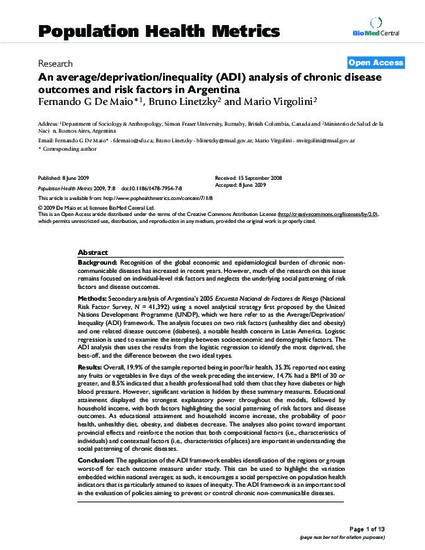
Article
An average/deprivation/inequality (ADI) analysis of chronic disease
Population Health Metrics
(2009)
Abstract
Background: Recognition of the global economic and epidemiological burden of chronic noncommunicable diseases has increased in recent years. However, much of the research on this issue remains focused on individual- level risk factors and neglects the underlying social patterning of risk factors and disease outcomes. Methods: Secondary analysis of Argentina's 2005 Encuesta Nacional de Factores de Riesgo (National Risk Factor Survey, N = 41,392) using a novel analytical strategy first proposed by the United Nations Development Programme (UNDP), which we here refer to as the Average / Deprivation / Inequality (ADI) framework. The analysis focuses on two risk factors (unhealthy diet and obesity) and one related disease outcome (diabetes), a notable health concern in Latin America. Logistic regression is used to examine the interplay between socioeconomic and demographic factors. The ADI analysis then uses the results from the logistic regression to identify the most deprived, the best-off, and the difference between the two ideal types. Results: Overall, 19.9% of the sample reported being in poor/fair health, 35.3% reported not eating any fruits or vegetables in five days of the week preceding the interview, 14.7% had a BMI of 30 or greater, and 8.5% indicated that a health professional had told them that they have diabetes or high blood sugar. However, significant variation is hidden by these summary measures. Educational attainment displayed the strongest explanatory power throughout the models, followed by household income, with both factors highlighting the social patterning of risk factors and disease outcomes. As educational attainment and household income increase, the probability of poor health, unhealthy diet, obesity, and diabetes decrease. The analyses also point toward important provincial effects and reinforce the notion that both compositional factors (i.e., characteristics of individuals) and contextual factors (i.e., characteristics of places) are important in understanding the social patterning of chronic diseases. Conclusion: The application of the ADI framework enables identification of the regions or groups worst-off for each outcome measure under study. This can be used to highlight the variation embedded within national averages; as such, it encourages a social perspective on population health indicators that is particularly attuned to issues of inequity. The ADI framework is an important tool in the evaluation of policies aiming to prevent or control chronic non-communicable diseases.
Disciplines
Publication Date
2009
Citation Information
De Maio, FG, Linetzky, B., and Virgolini, M (2009). An average/deprivation/inequality (ADI) analysis of chronic disease outcomes and risk factors in Argentina. Population Health Metrics, 7:8
